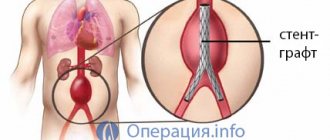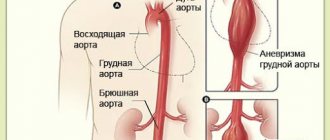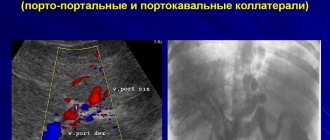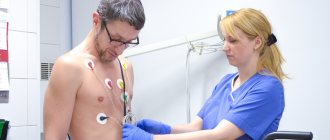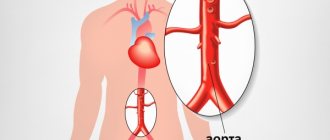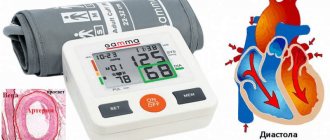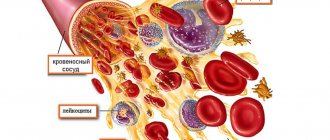The pathology of atherosclerosis is characterized by the gradual formation of cholesterol plaques.
The atherosclerotic process affects the entire bloodstream system, but there are also frequent cases of localization of cholesterol plaques in a specific section of the bloodstream.
Atherosclerosis of the abdominal aorta is a localization of atherosclerotic accumulation in the epigastric region of the aorta.
It is difficult to diagnose atherosclerosis in the abdominal part of the aorta at the first stage of development, because over a long period of time, the pathology does not show any visible symptoms.
Using biochemistry for cholesterol, it is possible to detect this pathology even in the preclinical stage of development and in the latent period. The pathology is determined by the lipogram, in which there are high indices of HDL, as well as VLDL and triglycerides.
What is characteristic of atherosclerosis of the abdominal aorta?
The nature of this pathology is that a disturbance in lipid metabolism occurs in the body, which leads to the deposition of excess lipoproteins on the internal arterial membranes and on the aorta. High levels of cholesterol in the blood are related to the formation of atherosclerotic plaques.
Over time, the plaques become overgrown with calcium ions and become hard. With atherosclerosis of the abdominal aorta, loss of elasticity of the aortic membranes occurs.
The disease is characterized by a violation of lipid metabolism, which leads to the deposition of cholesterol plaques on the walls of blood vessels.
Over time, they calcify, clog the lumen and lead to a deterioration in blood flow. Atherosclerosis of the abdominal aorta is characterized by a decrease in the elasticity of the vascular walls.
The aorta is the largest blood flow route in the human body.
It is divided into several departments:
- The beginning of the blood flow system is the thoracic aorta. This part of the aorta supplies the upper part of the human body with blood. These are the carotid and brachiocephalic arteries, which provide nutrition to brain cells. Also from the correct section of the aorta, there is a large artery that runs through the abdominal cavity and supplies blood to all the organs of the peritoneum;
- The lower section of the central trunk is divided into the abdominal artery and 2 trunks of the iliac arteries.
95.0% of all types of atherosclerosis are diagnosed in the aorta. Blockage of the abdominal aorta by atherosclerotic plaques causes ischemia of the peritoneal and pelvic organs.
The beginning of the blood flow system is the thoracic aorta
conclusions
Typically, atherosclerosis of the abdominal aorta occurs without clinical signs and has a generally favorable prognosis. Long-term pathomorphological studies have shown that the aorta in middle-aged people is almost always affected by an atherosclerotic process of varying degrees. The abdominal region, its bifurcation and the renal arteries are primarily affected. The clinical diagnosis is established belatedly, often indirectly, based on the development of occlusion, thrombosis and embolism. The danger of damage to the aorta lies in the high probability of life-threatening conditions: blockage of mesenteric vessels, bifurcation of the aorta and iliac segment with the development of gangrene, as well as aneurysm.
Causes of atherosclerosis of the abdominal aorta
The formation of atherosclerotic deposits occurs when lipid metabolism is disturbed, when low molecular density lipoproteins predominate in the blood and there are many free cholesterol molecules in the bloodstream.
This leads to the adhesion of fatty stains to the walls of the aorta.
The pathology can progress quite quickly due to the high concentration of cholesterol. When an atherosclerotic plaque closes the aortic lumen by 70.0% or more, ischemia of the cardiac organ begins to appear.
The causes of the development of atherosclerosis of the blood flow system, including aortic pathology, are:
- Genetic hereditary pathology hypercholesterolemia;
- Complete lack of physical activity and exercise;
- Pathologies of endocrine organs;
- Excess weight - obesity;
- Invasion of infectious agents;
- Adverse habits - alcohol and smoking;
- Poor nutrition and eating large amounts of animal fat;
- The degree of chronic overstrain of the nervous system.
Any of these reasons can provoke a disturbance in lipid metabolism, which leads to atherosclerosis.
Branches of the abdominal cavity
Causes of the disease
The main cause of atherosclerosis of the abdominal aorta is a violation of fat metabolism. Elevated blood levels of low-density lipoproteins (LDL) lead to the formation of cholesterol plaques.
Risk factors for the development of this pathology are:
- Genetic predisposition;
- Pathologies of the endocrine system (overweight or obesity, diabetes mellitus);
- Arterial hypertension - increased blood pressure more than 140 and 90 mmHg;
- Past infectious diseases (the main causes are herpes virus, Helicobacter pylori, Mycobacterium tuberculosis);
- Poor nutrition (eating fatty, fried, spicy foods);
- Adverse habits (smoking, drinking alcohol);
- Physical inactivity – low physical activity;
- Constant emotional stress, frequent stressful situations;
- Decreased immune strength of the body.
As a rule, atherosclerosis of the abdominal cavity develops due to several factors. Some of them are non-modifiable, that is, unchangeable - for example, heredity, congenital diseases. But most of them can be excluded.
Thus, giving up bad habits, normalizing nutrition, and maintaining an active lifestyle can significantly reduce the risk of pathology.
Classification of pathology
In medicine, occlusion is divided into 3 degrees of blockage of the aortic lumen.
According to this classification, the degree of organ ischemia is diagnosed:
- Low degree of occlusion. Bifurcation of the abdominal aorta appears;
- Average degree of occlusion. There is blockage of the aortic lumen at the maximum level;
- Severe aortic occlusion is when calcified atherosclerotic plaques block the lumen below the area of the renal arteries.
In diagnostic centers there is a Fontaine classification of abdominal aortic atherosclerosis.
She divides pathology into 4 stages of its development:
- Preclinical stage of development. The pathology is asymptomatic. When examined by instrumental methods, atherosclerosis is not observed. The amount of lipoproteins in the blood does not exceed standard values. A detailed biochemical analysis of blood composition reveals an increase in LDL molecules and signs of hypercholesterolemia. To prevent the development of atherosclerosis, it is necessary to adjust nutrition and take preventive measures to lower cholesterol;
- Latent stage of development of atherosclerosis. With instrumental diagnostics, the degree of change in the aortic membrane is visible. With changes in lipid metabolism and pathologies in the blood flow system, the patient is diagnosed with atherosclerosis of the abdominal aorta;
- Stage of nonspecific signs of manifestation. The patient feels ischemia of the abdominal organs during sleep. Atherosclerosis can be detected using instrumental diagnostics;
- Stage of manifestation of the chronic degree of aortic occlusion and trophic signs on the skin. Ischemia occurs in the walls of the aorta and peritoneal organs, and fibrous disorders occur in the cells of the organ tissues.
Stages of development of atherosclerosis
Classification
Atherosclerosis of abdominal vessels is classified according to several parameters. Depending on the degree of vascular obstruction, the pathology may be accompanied by:
- low occlusion;
- average occlusion;
- high occlusion.
As the disease progresses, it goes through 4 stages of the process:
- preclinical;
- latent;
- stage of nonspecific symptoms;
- chronic.
The preclinical stage is characterized by the absence of pronounced clinical manifestations. Moreover, even with instrumental diagnostics it is not possible to identify signs of pathology. Only a laboratory analysis can detect the presence of an increased concentration of cholesterol in the blood.
Important information: Exercise therapy exercises for atherosclerosis of the vessels of the lower extremities
At the latent stage there are still no pronounced clinical signs, but pathology can be detected during laboratory and instrumental studies. There are pronounced disorders of fat metabolism.
At the next stage, nonspecific clinical signs appear, resulting from tissue malnutrition and progression of the ischemic process. There are disturbances in the functioning of internal organs that do not receive enough oxygen and nutrients. The degree of severity of atherosclerotic layers at this stage is determined during instrumental studies.
The transition of the disease to a chronic form is accompanied by severe circulatory disorders and an increase in ischemic damage to the vessel and adjacent tissues. The affected areas are rapidly replaced by fibrous tissue.
Complications of the development of atherosclerosis of the abdominal aorta
In addition to the development of thrombosis in the main arteries, atherosclerosis of the peritoneal aorta can develop renal organ failure.
The complicated form of atherosclerosis goes through several stages of development, and at each stage, with timely treatment, good results can be achieved:
- First degree of ischemia. The pathology manifests itself as lameness, pain in the abdominal cavity, and sometimes there are manifestations of angina pectoris;
- Thrombonecrotic degree of development of atherosclerosis. The pathology reaches a chronic stage and often complications such as gangrene of the affected limb, cardiac infarction, and stroke develop due to thrombosis;
- The last stage of development of complicated atherosclerosis of the abdominal aorta is fibrous. At this stage, there is a threat of developing cardiosclerosis, as well as aortic aneurysm. 90.0% of aortic aneurysm rupture is fatal.
Risk factors and symptoms of the disease
The danger of atherosclerosis is that complex damage occurs to the aorta along with the veins and arteries extending from it. Atherosclerosis affects the abdominal artery more often than the thoracic artery, and its causes are:
- Alcohol and smoking abuse, drug use;
- Hypertension and chronic form of hypertension;
- Physical inactivity;
- Increased blood cholesterol levels;
- Stress and being in an uncomfortable psychological climate;
- Changes in hormonal levels;
- Poor nutrition;
- Obesity;
- Disruption of the endocrine system;
- Diabetes;
- Weak immune system;
- Dyslipidemia.
Also, the causes of the disease lie in hereditary predisposition and age-related changes in the body. The high-risk group includes people over 45 years of age. The risk of developing the disease depends on the number of factors and their combination.
A sedentary lifestyle combined with hypertension and excess weight is more likely to lead to atherosclerosis and ischemia.
Signs and symptoms
The initial stage is characterized by such symptoms as weakness, decreased performance, dizziness and facial parasthesia. People complain of irritability and decreased concentration, and fatigue. While walking, pain and cramps occur. These symptoms are called wandering claudication because they go away on their own without the use of medication after rest. This same stage is characterized by abdominal pain and in the right hypochondrium, frequent belching and constipation. Symptoms are not constant and may disappear for a while.
The next stage is characterized by anxiety and depression, hypochondria, weakening of memory and decreased overall activity, poor perception of new information. As the disease progresses, the legs begin to ache even with light exertion, and the pain is accompanied by a feeling of coldness in the fingers. The hair on the legs of men decreases sharply. Swelling and numbness of the extremities are often observed. In men, this stage of the disease may be accompanied by impotence.
The manifestation of the disease can be recognized by other signs:
- The appearance of ulcers on the fingers and heels;
- Dry skin on the feet and cracked heels;
- Muscle weakness of the legs;
- Tissue necrosis;
- Pulsation in the navel area;
- Heartburn, belching and nausea after eating;
- Bloating and flatulence.
In a complicated period, prolonged and severe attacks of pain in the central abdomen may occur.
When using antispasmodic medications, diarrhea becomes a side effect, and pieces of undigested food are released along with the feces.
What could be the consequences?
- Atherosclerosis can lead to:
- The occurrence of ischemic and hemorrhagic strokes;
- Impaired kidney function and acute renal failure;
- Reduced blood supply to the kidneys and heart;
- angina pectoris;
- Impaired heart function;
- Sudden surges in blood pressure and arterial hypertension;
- Necrosis of the intestinal walls;
- Inflammation of internal organs.
Atherosclerosis often causes the death of intestinal loops, which ends in peritonitis. The presence of thrombosis provokes inflammatory processes and tissue necrosis. The formation of plaques is accompanied by the development of thrombosis and embolism, which disrupt the functioning of the intestines and kidneys.
If left untreated, a very serious complication develops in the form of gangrene of the legs, which often ends in amputation of the limb and even death of the patient. An aortic aneurysm can also lead to death. An aneurysm is an enlargement of a vessel in a weakened area. The development of an aneurysm can be noticed by pulsation in the abdomen, sharp pain in the lower back occurs, which is accompanied by vomiting.
In advanced cases, complications of an aneurysm include:
- Rupture of the abdominal aorta and severe bleeding;
- The appearance of a blood clot and impaired blood flow.
Insufficient blood supply leads to the replacement of healthy tissue with connective tissue, which causes swelling of the fingers and feet, urinary retention and changes in the chemical composition of urine. Abdominal aortic aneurysms with a diameter greater than 50 mm require surgical intervention. Aneurysms are removed, prostheses are placed in their place, or a wire frame is inserted into the affected vessel to normalize blood flow.
Symptoms of atherosclerosis of the abdominal aorta
In 95% of patients, atherosclerosis manifests itself as moderate pain in the peritoneum or severe pain. Localization of pain can be in various parts of the abdominal cavity.
Symptoms of atherocalcinosis may include:
- Pain in parts of the digestive tract when eating food. This symptomatology occurs due to a lack of blood flow to the digestive organs;
- Impaired functioning of all parts of the intestine;
- Loss of body weight.
If you experience such symptoms, you must immediately consult a doctor to receive qualified treatment. You cannot self-medicate and relieve pain with painkillers.
If diagnosis is not made in a timely manner, precious treatment of the pathology may be missed at earlier stages of therapy. The intensity of painful symptoms is commensurate with the stage of development of atherosclerosis.
With a non-stenotic type of atherosclerosis of the aorta of the abdominal region, a change in the aortic membrane is noted.
The patient experiences the following symptoms:
- Circling in the head;
- Noise in the auditory organ;
- Weakness of the lower extremities;
- Numbness in the affected leg.
Photo gallery: Symptoms of the disease
Pain during meals
Bowel problems
Reducing body weight
How are they treated?
One of the stages of treatment is the exclusion of fatty and fried foods from the diet.
If a patient has atherosclerosis of the abdominal cavity, then therapy for him should be comprehensive and aimed at normalizing cholesterol levels and restoring blood flow through the affected artery. Proper nutrition with the exclusion of fatty, fried and spicy foods from the diet, as well as medication in the form of constant use of statins, fibrates and angioprotective agents will help reduce the amount of LDL in the blood. If conservative measures are ineffective, surgery is recommended. For a single lesion, stenting is performed, and diffuse atherosclerosis is recommended to be treated with shunting. A doctor who performs this type of surgical procedure is called a vascular surgeon. In combination with traditional methods of treatment, therapy with folk remedies can be carried out.
Treatment with drugs
Atherosclerosis of the abdominal aorta is an indication for the use of statins and fibrates, which prevent plaque formation. In addition, bile acid sequestrants are used to reduce the absorption of cholesterol in the intestine. Thrombolytics and vitamin-mineral complexes are also used. Angioprotectors that prevent vascular damage are also useful.
Operational impact
If atherosclerosis of the abdominal aorta has led to complete occlusion of the vessel, then surgical intervention is recommended. The choice of its type depends on the distribution of atherosclerotic lesions. In case of a single lesion, a stent is placed. During the operation, a probe is inserted through the femoral artery of a special device. At the installation site, the stent opens, expanding the lumen of the vessel. When the aortic lesion is diffuse, shunting is indicated to create an artificial blood flow bypassing the affected arteries.
Atherosclerosis of the arteries of the lower extremities occurs as a result of damage to the abdominal aorta.
Treatment with folk remedies and nutrition
Viburnum infusion is used for atherosclerosis, but before use it is necessary to consult a doctor.
Non-traditional methods of therapy are used only in combination with the main treatment. They are widely available, but are not effective enough and can only maintain cholesterol levels and stop the progression of the disease. Tinctures made from rose hips, garlic, viburnum or hawthorn are recommended. Proper nutrition for atherosclerosis brings positive results only in the initial stages of the disease. The diet should be prescribed by a nutritionist.
Diagnostics
In order to begin the therapeutic process of eliminating atherosclerotic deposits on the aorta, it is necessary to establish a diagnosis for the correct treatment method.
If severe symptoms of a disorder in the digestive tract appear, then the patient needs to consult a gastroenterologist for a comprehensive examination of the body for the development of atherosclerosis of the aorta in the abdominal region.
In most cases, to make a diagnosis it is necessary to undergo laboratory blood tests and undergo an instrumental pathology study.
For laboratory clinical tests, it is necessary to donate blood to:
- General analysis of blood composition;
- Blood plasma clotting test;
- Biochemical analysis for cholesterol;
- Advanced analysis using the lipid spectrum method.
Instrumental diagnostics consists of the following methods of studying the body:
- Ultrasound (ultrasound examination) of the abdominal cavity;
- Gastroscopy method;
- Aortoangiography technique;
- Duplex or triplex scanning of the main arteries and aorta in the abdominal cavity;
- Angiography of the aorta and its branches.
These instrumental studies make it possible to identify the pathology of atherosclerosis at the initial stage of development of cholesterol deposits.
The patient should consult a gastroenterologist
Symptoms and methods of treatment of atherosclerosis of the abdominal aorta
Atherosclerosis of the aorta, and especially the abdominal part, is a very common disease of the cardiovascular system. It affects mainly elderly people, but the pathology has a tendency towards rejuvenation - increasingly, its symptoms appear at an early age.
Today we will look at the first symptoms that may indicate atherosclerosis of the abdominal aorta, the rules of diagnosis, prevention and treatment.
The lower ( abdominal - BOA) section gives off branches that supply blood to most of the internal organs of the large and small pelvis - kidneys, liver, loops of the small and large intestines, spleen, skin. Damage to an artery of this caliber can lead to multiple disruptions in the functioning of various body systems.
Symptoms of the disease
The main symptom of atherosclerosis of the abdominal vessels is pain and discomfort in the abdominal area.
The severity of clinical manifestations depends on the stage of the lesion:
- Ischemic stage. At the initial stage, periodic disruption of the blood supply to organs and tissues occurs - a person suffers from attacks of angina pectoris, abdominal pain, intermittent claudication - the occurrence of pain and paresthesia in the legs when walking.
- Thrombonecrotic stage. At this stage, the risk of blood clot rupture and occlusion of smaller arteries increases, which causes myocardial and cerebral infarctions (stroke).
- Fibrous stage. With a long course of the disease, chronic ischemia of organs is observed, as a result of which their tissue is converted into fibrous tissue.
In addition to clinical stages, signs of atherosclerosis in the abdominal aorta depend on the level of blockage. Such symptoms will be presented in the table.
Diagnosis of atherosclerosis of the abdominal aorta includes basic and additional research methods.
Prevention and treatment of the disease
At the first visit of the patient, the general state of health is established, symptoms are identified and blood pressure levels are measured. Mandatory procedures include conducting a biochemical blood test and a general urine test.
When diagnosing atherosclerosis of the abdominal aorta, the value of the brachial-ankle index is determined. It is calculated by the difference in blood pressure in the ankle and shoulder. In normal conditions, these indicators are equal. If the level of pressure in the ankle is 2 times the level of pressure in the shoulder, this indicates a violation of blood flow in the legs.
Using ultrasound Dopplerography of blood vessels, the level of the overgrowth is determined. Duplex angioscanning also uses ultrasound to determine the speed of blood flow, the presence of fat deposits and the degree of development of pathologies. Based on the results of the examination, a treatment method is selected: surgical or medicinal.
If it is necessary to establish the level of reduction in blood flow, then rheovasography is prescribed. It is based on recording the electrical conductivity of tissues that occurs when they are filled with blood.
Nicotinic acid preparations are often used. It reduces the rate of production of low-density lipoproteins. To avoid side effects, nicotinic acid is prescribed together with aspirin and ascorbic acid.
Treatment of sclerosis of the abdominal aorta
It is necessary to treat aortic atherosclerosis in the abdominal region in a comprehensive manner. In the process of prescribing therapy, it is necessary to take into account the patient’s age, his gender, the reasons for the development of the pathology and the degree of its progression.
Treatment begins with reducing the cholesterol index in the blood:
- Switch to a cholesterol-free diet;
- To refuse from bad habits;
- Use drugs based on traditional medicine;
- Use medications in treatment.
Drug therapy consists of the following pharmacological groups of drugs:
- A group of drugs called statins - they reduce the synthesis of cholesterol molecules by liver cells;
- Antiplatelet agents - the properties of drugs to dilute the plasma composition of the blood;
- A group of fibrate drugs - reduce the production of low-density lipids;
- Antioxidant - vitamin B;
- Calcium antagonist drugs.
Drug therapy
Treatment with traditional medicine
Treatment of aortic sclerosis in the abdominal region with drugs based on recipes from traditional healers can be used as an adjuvant therapy to the main medicinal methods and only with the permission of the treating doctor.
For treatment it is necessary to use the following medicinal herbs, plants and healing potions prepared on their basis:
- It is necessary to use plants that reduce the cholesterol index in the blood. To do this, it is worth using alcohol tinctures based on garlic and barley, as well as decoctions of flax seeds and milk thistle teas;
- It is necessary to use plants that have the properties of diluting blood plasma in treatment. Strawberry and raspberry leaves, green shoots of hawthorn and chokeberry, and leaves and flowers of mistletoe have such properties. Decoctions based on them will help avoid the formation of blood clots in the bloodstream.
Diagnosis of dilatation and occlusion of the abdominal aorta
Diagnosis of aortoiliac segment obliteration consists of a thorough clinical examination, which includes both invasive and non-invasive techniques. The most commonly used is Doppler sonography, which allows one to assess the degree of narrowing, its location and extent. The collected information allows you to decide on treatment.
If the results show that surgery is necessary, then CT or conventional angiography is used, which involves injecting contrast through a catheter into the aorta.
Angiography allows you to clearly examine the affected vessel and determine what type of operation is necessary in this particular case.
An aneurysm is often discovered by chance when an abdominal ultrasound is performed. This study allows you to determine the size of the vessel dilation. Ultrasound is also used for monitoring purposes. Computed tomography with intra-arterial contrast is still considered the gold standard for abdominal aortic aneurysm evaluation, with a sensitivity of almost 100%.
Prevention
Preventive measures are aimed at reducing the cholesterol index in the blood and preventing atherosclerotic formations on the walls of the abdominal aorta:
- Quitting smoking and drinking alcohol;
- Increase physical activity and play sports;
- Constantly fight extra pounds;
- Follow a diet with a minimum amount of animal food;
- Monitor your glucose and blood pressure index and constantly treat hypertension and diabetes.
Quit smoking and alcohol
Symptoms
For a long time, there are no pronounced symptoms of atherosclerosis of the abdominal aorta. Clinical symptoms of the disease appear only after severe disruption of blood flow due to the formation of atherosclerotic plaques. The first signs of the disease are nonspecific. First, the patient begins to periodically experience discomfort and heaviness in the abdomen. Subsequently, symptoms such as:
- abdominal pain after eating;
- attacks of nausea;
- heartburn;
- pulsation and tension in the navel area;
- stool disorders;
- weight loss.
Periodically, against the background of this pathology, attacks of increased body temperature are possible. A person gradually loses his ability to work due to constantly present weakness. When a section of the aorta is damaged at the site of its branching into the iliac arteries, signs of circulatory disorders are observed in the soft tissues and pelvic organs. Symptomatic manifestations that occur during this course of pathology include:
- worsening pulse in the arteries of the feet;
- numbness;
- cold extremities;
- decreased muscle tone;
- trophic ulcers;
- erectile dysfunction in men, etc.
Often the course of this pathological condition is complicated by the formation of aortic aneurysms, which, if ruptured, in most cases lead to death. With severe blockage of the aorta, inflammatory damage to the abdominal organs may occur. In severe cases, pancreatitis and gangrene develop. With such an unfavorable course of the disease, death is possible. The pathology can be complicated by intestinal infarction, stroke, and sudden surges in pressure.
Important information: Is it possible to take bath procedures for atherosclerosis of the lower extremities?
Dietary nutrition for atherosclerosis of the abdominal aorta
When treating pathologies associated with high cholesterol, it is necessary to include an anti-cholesterol diet, which helps medications lower blood lipids.
The essence of the diet is that it is necessary to limit the consumption of animal products, which are suppliers of cholesterol to the body from the outside.
Animal fats must be replaced with vegetable oils. If possible, minimize your carbohydrate intake and completely avoid sugar.
Consume no more than 2.0 grams of salt per day.
Eat 5 - 6 times a day. The maximum amount of food in the diet should be vegetables and fruits. Introduce sea fish into your diet (up to 4 times a week) and low-fat meats (chicken, turkey).
Treatment of the disease
Treatment of atherosclerosis of the abdominal aorta is complex. It includes following a diet, taking medications, as well as traditional medicine.
Therapy for the disease is selected individually, taking into account gender, age, risk factors and concomitant pathologies.
Diet
Diet for atherosclerosis is both a method of prevention and treatment. A balanced diet prevents an increase in cholesterol levels in the blood, maintaining the elasticity and lumen of blood vessels.
Nutrition includes the following principles:
- The energy value of the daily diet should be in the range of 2300-2600 Kcal;
- Limiting simple carbohydrates in the diet (sweets, baked goods);
- Increasing the consumption of protein products (lean meats and fish, dairy products);
- Limiting salt intake (no more than 5 g per day);
- Five to six meals a day in small portions with breaks of 2.5-3 hours;
- No snacking;
- Drinking enough fluid – 1.2-1.5 liters per day;
- The preferred heat treatment of food is boiling, stewing, steaming.
Drug therapy
In the treatment of atherosclerosis, a whole range of drugs is prescribed that eliminate both the cause (etiotropic drugs) and the signs of atherosclerosis (symptomatic drugs).
In some cases, specialists resort to surgical treatment. The operation involves removing the blood clot and replacing the damaged vessel. Typically, such intervention is resorted to when the arteries of the abdominal organs are damaged.
